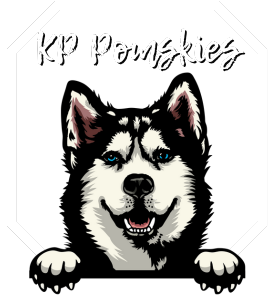Brindle Point - A First in Pomskies
You may have heard me reference this term when speaking about Brinley’s puppies. Many have asked what this is.
Brindle is a coat pattern where striping appears. Brinley, my foundation dam is a good example of a brindle. You can see the striping pattern on her.
Brindle is rare in Pomskies. Puppies are often born a solid color and the stripes do not come in until much later. At times, the brindle striping is “broken” or not well patterned and produces a strange looking coat. However, Brinley (shown to the right) has a stunning well delineated brindle striped coat.
When I began intentionally breeding brindle, it was a risk. It requires a considerable amount of education of the consumers if I had straight brindle babies, because the striping doesn’t appear until later. And the risk of oddly or minimally marked brindles is high. I do not offer breed rights on Brinley’s litters for these reasons.
The image to the right is Brinley as a baby. Most people would have been hard pressed to imagine her current striped look based on this.
Brindle point was considered genetically impossible by many Pomsky breeders, until now. The offspring of Brinley have produced the first known brindle points in the Pomsky world (to our knowledge).
Is it genetically impossible? No. Brindle points have appeared in Poodles, Sheepdogs, Bull Terriers, Corgis, and other breeds.
Brindle is especially challenging because there is not currently a DNA test on the market that will test for brindle specifically. And brindle knowledge is difficult to find and understand.
What we do know is that it expresses (is visible) if kbr is present. If K is present, it dominates and brindle will not express. And if kbr is not present, it will not have brindle.
I would love there to be a K Locus test that shows the brindle allele lengths so we can better explore this awesome coat pattern. As science and canine DNA progresses, I look forward to seeing this make an appearance.
The below information is taken from this page: http://www.doggenetics.co.uk/brindle.html
“Brindle Tan Points and Saddle Markings
Because the brindle gene allows expression of the A locus, any A locus coat patterns can show brindling on their red sections. The main patterns are sable (AyAy) and tan points (atat). A sable brindle will appear solid brindle (in fact, all solid brindles are sables), although any areas of shading will remain dark. A tan pointed dog with the brindle gene will appear black/liver/blue/isabella with brindle points instead of tan.
There is one apparent exception to the rule that only the tan areas on a dog show brindle striping. Dogs with the Eg (grizzle/domino) allele seem to show brindle mostly on their darker areas or saddles, as the Saluki puppy above shows. These dogs look very similar to a saddle tan or shaded sable, but the pattern is caused by a different mechanism. See the E series page for more information on grizzles and how Eg interacts with brindle. It is possible that the Eh allele (which causes a similar pattern in Cocker Spaniels) and the Ed allele (Northern domino, in Husky types) interact with brindle in a similar way too.”
Additional Brindle Resources:
This is Puppaccino’s genetic panel. When he was born, I had spent the first few weeks of his life trying to determine what to call his coat color. After hours of research and speaking with coat color experts, Embark DNA geneticists, and others, it was determined he was a brindle point. There were 3 brindle points in Brinley’s first litter, although Puppaccino was by far the best marked, brindle striping did appear on the socks of 2 others in his litter.
In Brinley’s second litter, DOB April 2021, she produced a dark sable brindle point, a black/white brindle point, and a chocolate brindle point. Two of the three have strong white Ed domino “Husky Mask” markings present as well.
As we learn more about this amazing genetics, I will update this page.
If you have additional information on brindle and brindle points, please email me.




